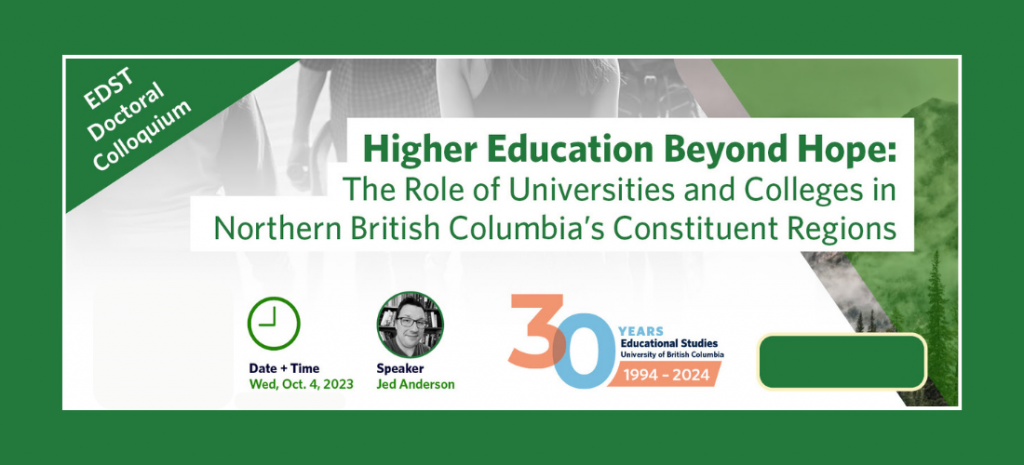Beginning this October…
EDST will host a Doctoral Colloquium. Once a month doctoral students and candidates will present their research to department students, staff and faculty. After their presentations, speakers will respond to audience questions. In this blog post, the Doctoral Colloquium coordinator, Yotam Ronen, summarizes the first of these presentations, given by EDST PhD Candidate, Jed Anderson.
What does it mean to live in a Northern peripheral region in both the global and Canadian context? What happens when settlers leave after colonizing a Northern area? In what ways is higher education implicated in these questions? These are the topics that Jed Anderson discussed in the first meeting of the EDST Doctoral Colloquium.

Anderson brought together Marxist theories on capitalism and colonization, works on Imperial communication and industrialization, as well as theoretical work on geographical space, to analyze Northern British Columbia and the development of higher education there. Using methods from political history and historical geography, Anderson conducted textual and document analysis, synthesizing his findings and positioning them in their spatial and temporal context.
This framework yielded an analysis that differentiated between three regions in Northern BC—Northcentral BC, Northeastern BC, and Northwestern BC—each with its own particular characteristics and its own unique trends of colonization.
Driven by resource extraction, the developing railway system in Northcentral BC brought with it the development of higher education institutions on the railway path.
In the Northeast, hopes for gold extraction were supplanted by an agricultural land-rush shaped by the formulation of scientific colonization. This Great Depression-era settlement effort was planned and closely monitored by researchers from both BC and Alberta. This colonization was accompanied by the establishment of higher education institutions alongside scientific colonization efforts, and soon after struggles over jurisdiction of these institutions ensued between Alberta and British Columbia. Here, a flourishing arts program was consistently defunded, and resources were transitioned towards resource extraction.
Finally, the Northwest saw the earliest violent contact between settlers and Indigenous people, where multiple imperial projects competed for the same space. Massive industrial projects in the region before and after World War Two brought in settlers, but when these projects winded down, a process of unsettlement occurred by which settlers left for economic reasons and Indigenous people asserted their right to self-determination. This opportunity for Indigenous capacity-building was reflected, among other things, in new higher education institutions that emphasized Indigenous perspectives and needs.
![]()
An examination of these three regions shows how, despite an expected level of homogeneity, there is considerable diversity in the development of higher education in Northern BC. Differing contexts and contingencies, coupled with the weakening of colonial institutions, allowed for considerable change in the three regions, that is reflected in the development of higher education and the sort of challenges and questions that each region grapples with. Furthermore, this examination highlights the significance of conversations on unsettlement, the place of the arts in higher education, and the close ties between industry, capital, colonialism, and higher education.

The second meeting of the EDST Doctoral Colloquium is next week (November 1st)!
PhD candidate, Miranda Huron, will present on the topic of “Co-developing the Indigenous Languages Act of Canada: Indigenous Roles in the Policy Process”.
November 1st, 2023, at 11 am, in PCOH 2012.





 Share
Share